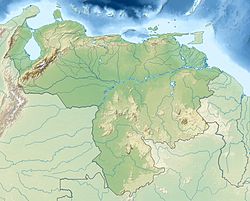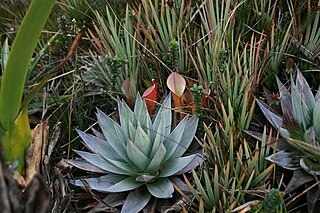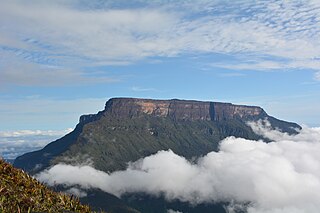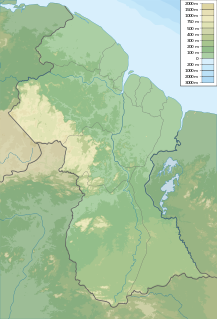| Murisipán-tepui | |
|---|---|
| Highest point | |
| Elevation | 2,350 m (7,710 ft) [1] |
| Coordinates | 05°52′11″N62°04′32″W / 5.86972°N 62.07556°W Coordinates: 05°52′11″N62°04′32″W / 5.86972°N 62.07556°W |
| Geography | |
| Location | Bolívar, Venezuela |
Murisipán-tepui, also spelled Murosipán or Murochiopán, is one of the four main tepuis of the Los Testigos chain in Bolívar, Venezuela. [1] Looking west to east, it is the second major peak of the massif and is connected to the next two—Tereke-yurén-tepui and Kamarkawarai-tepui—by a common basement (the westernmost peak, Aparamán-tepui, is relatively isolated by comparison). Murisipán-tepui has an elevation of around 2,350 metres (7,700 ft) and a summit area of 5 km2 (1.9 sq mi). The mountain's mostly bare summit plateau has a small, seasonal lagoon near its centre. [1]

A tepui, or tepuy, is a table-top mountain or mesa found in the Guiana Highlands of South America, especially in Venezuela and western Guyana. The word tepui means "house of the gods" in the native tongue of the Pemon, the indigenous people who inhabit the Gran Sabana.

Los Testigos, also known as the Aparamán range, is a mountain chain in Bolívar, Venezuela. It consists of four rather small tepuis, forming a bridge between the giant Auyán-tepui to the west and Ptari-tepui to the east. The four major peaks of Los Testigos are : Aparamán-tepui (2,100 m), Murisipán-tepui (2,350 m), Tereke-yurén-tepui (1,900 m), and Kamarkawarai-tepui (2,400 m), the latter three sharing a common slope area. There however remains some confusion in the literature regarding the names of these peaks.
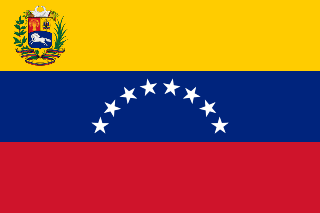
Venezuela, officially the Bolivarian Republic of Venezuela, is a country on the northern coast of South America, consisting of a continental landmass and a large number of small islands and islets in the Caribbean Sea. The capital and largest urban agglomeration is the city of Caracas. It has a territorial extension of 916,445 km2. The continental territory is bordered on the north by the Caribbean Sea and the Atlantic Ocean, on the west by Colombia, Brazil on the south, Trinidad and Tobago to the north-east and on the east by Guyana. With this last country, the Venezuelan government maintains a claim for Guayana Esequiba over an area of 159,542 km2. For its maritime areas, it exercises sovereignty over 71,295 km2 of territorial waters, 22,224 km2 in its contiguous zone, 471,507 km2 of the Caribbean Sea and the Atlantic Ocean under the concept of exclusive economic zone, and 99,889 km2 of continental shelf. This marine area borders those of 13 states. The country has extremely high biodiversity and is ranked seventh in the world's list of nations with the most number of species. There are habitats ranging from the Andes Mountains in the west to the Amazon basin rain-forest in the south via extensive llanos plains, the Caribbean coast and the Orinoco River Delta in the east.
In his 1978 book, La Vegetación del Mundo Perdido, Charles Brewer-Carías applied the name Murochiopán-tepui to a smaller lateral peak of Aparamán-tepui ( 05°52′32″N62°06′48″W / 5.87556°N 62.11333°W ), calling the high summit immediately east of it Tereke Yurén-tepui and the tiny peak east of that, Tucuy-wo-cuyén-tepui. Subsequent authors have generally used Murisipán-tepui (or its variants) for the second of the four main peaks, and Tereke-yurén-tepui for the third, with the lateral mountain of Aparamán-tepui going unnamed. [1]
Charles Brewer-Carías is a Venezuelan explorer and naturalist. Known as the "Humboldt of the twentieth century", Brewer-Carías has led more than 200 expeditions to remote parts of the Venezuelan Guayana, particularly the tepuis of the region. His discoveries include the sink holes of Cerro Sarisariñama and the world's largest known quartzite cave, Cueva Charles Brewer.

Tereke-yurén-tepui is one of the four main tepuis of the Los Testigos chain in Bolívar, Venezuela. Looking west to east, it is the third major peak of the massif and is connected to Murisipán-tepui and Kamarkawarai-tepui by a common basement. With a summit area of 0.63 km2 (0.24 sq mi) and an elevation of around 1,900 metres (6,200 ft), Tereke-yurén-tepui is both the smallest and lowest of the four peaks. Its summit plateau comprises mostly bare rock.
The frog species Anomaloglossus murisipanensis is only known from Murisipán-tepui. [2]
Anomaloglossus murisipanensis is a species of frog in the Aromobatidae family. It is endemic to Venezuela where it is known from its type locality, the Murisipán-tepui in the Bolívar state. It is known from only one specimen collected under a rock in tropical montane forest.
